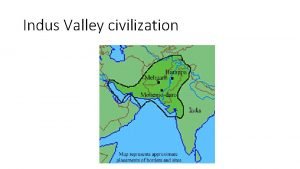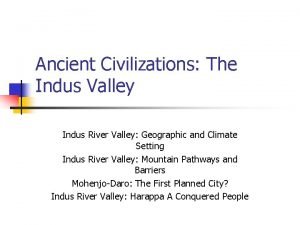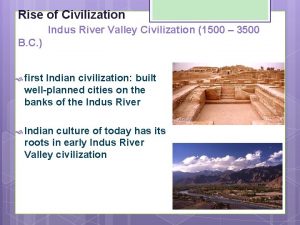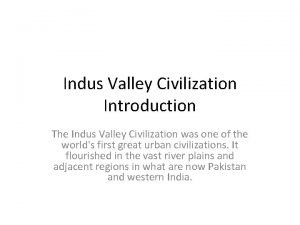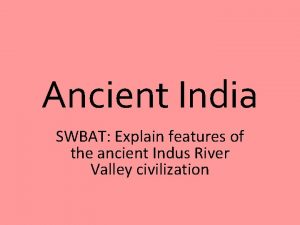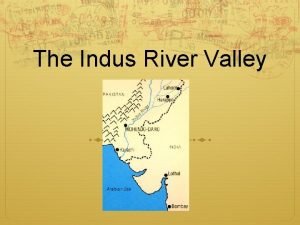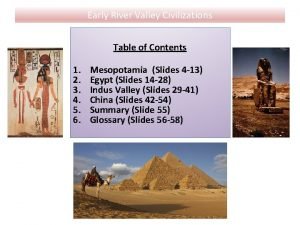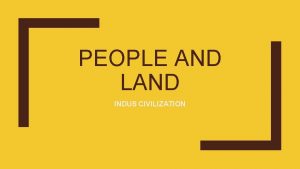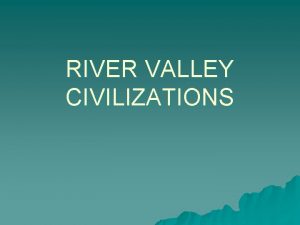INDUS RIVER VALLEY FOCUS QUESTIONS Focus Questions 1










- Slides: 10

INDUS RIVER VALLEY FOCUS QUESTIONS

Focus Questions 1. 2. 3. 4. What are the origins of Harappan society in the Indus River valley? What were the features of Harappan society and culture? What are theories behind Harappan decline? How did the Indo-European migrations influence the development of early India? 5. What factors contributed to the development of the caste system? 6. What factors led to the establishment of patriarchal authority in ancient India 7. What were the key elements of Aryan religious beliefs and practices and how did they blend with Dravidian values?

What are the origins of Harappan society in the Indus River valley? • Began around 7000 BCE • Centered in modern day India and Pakistan • Relied on the sometimes erratic flooding of the Indus river for depositing silt to grow wheat, barley, and cotton. • Also herded cattle, sheep, and goats • Population expanded across India around 3000 BCE • We may someday learn more, haven’t deciphered their writing yet

What were the features of Harappan society and culture? • Two large urban centers: Mohenjo-daro and Harappa. • We don’t know much about their political system, but the organization of these cities suggest strong centralized rule • Traded with Mesopotamia, Persia, and along the coast of the Arabian Sea. • Economy was diverse, with labor specialization and complex social structure • Like other river valley civilizations, polytheistic religion centered on creation and procreation

What are theories behind Harappan decline? Agricultural output declined due to • Ecological degradation such as deforestation and desertification • Natural catastrophes By 1500 BCE, most Harappan cities collapsed

How did the Indo-European migrations influence the development of early India? • Nomadic pastoral peoples called Aryans migrated into the region and established communities based on herding and agriculture in Northern India. • Their language, Sanskrit, is the base of most Indian languages • Their sacred texts, the Vedas, formed the foundation of Hinduism • Tribal chiefdoms led by Rajas eventually developed into regional kingdoms. • Built permanent capitals employed professional administrators • Introduced the caste system

What factors contributed to the development of the caste system? • The caste system, or varna was first introduced by the Aryans • The varna grouped people according to their occupations and roles in society. • As Aryan’s interacted with Dravidians (natives), they shifted to a hierarchy based on Aryan or Dravidian ancestry (skin color). • Over time, these racial distinctions have become less clear. • Eventually even subcastes (jati) were introduced, each with their own rules governing behavior.

What factors led to the establishment of patriarchal authority in ancient India? • Agriculture = Patriarchy • Aryans, were also patriarchal. Descent was traced through the father’s line. • Women had no public authority and could only inherit land if there were no male heirs. • Women could not preside over religious rituals and received no education • Lawbook of Manu: further promoted patriarchal authority as a moral value • Other examples of patriarchy in India: sati (see key terms) and child marriage.

What were the key elements of Aryan religious beliefs and practices and how did they blend with Dravidian values? • Polytheistic with gods for all types of natural phenomena. Indra, the god of war and weather, was most important to Aryans. Varuna governed human behavior and rewarded good and punished evil. • Early Aryans practiced animal sacrifice and the use of hallucinogenic drugs. Eventually this gave way to a focus on meditation and studying religious texts • What the Dravidians brought in: reincarnation, and a focus on what happens after death. • The Upanishads reflect this blending of Aryan Vedic religion and the Dravidian’s beliefs

INDUS RIVER VALLEY FOCUS QUESTIONS
 Modern day indus valley
Modern day indus valley Proto siva
Proto siva Indus river valley
Indus river valley River valley civilizations
River valley civilizations Introduction of indus valley civilization
Introduction of indus valley civilization Indus river valley dbq
Indus river valley dbq River valley civilizations characteristics
River valley civilizations characteristics Indus valley gender roles
Indus valley gender roles Indus and ganges river
Indus and ganges river Indus river valley civilization cloze reading
Indus river valley civilization cloze reading Growing up in the indus valley
Growing up in the indus valley
